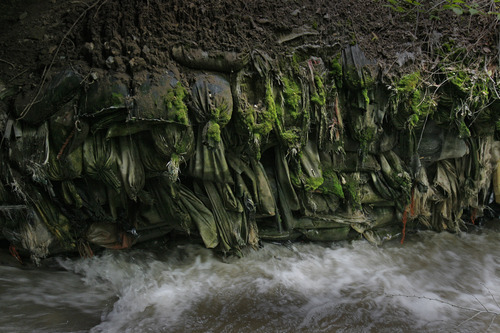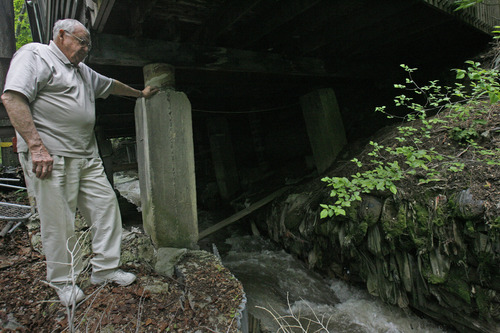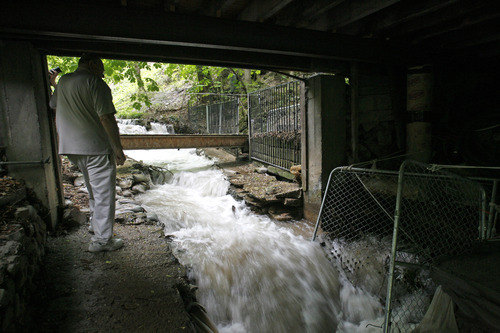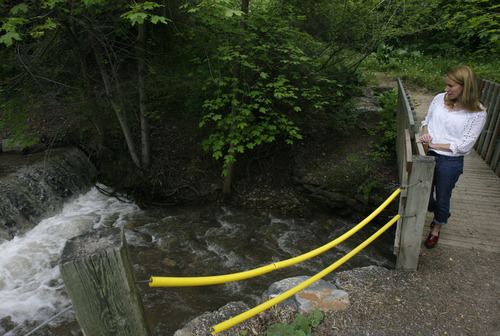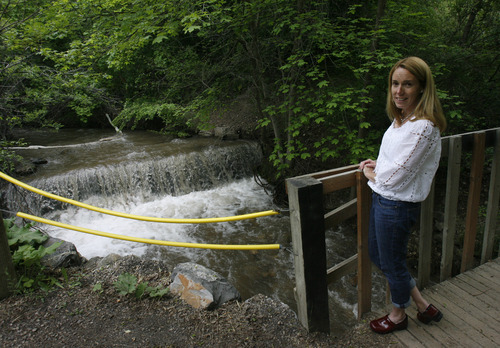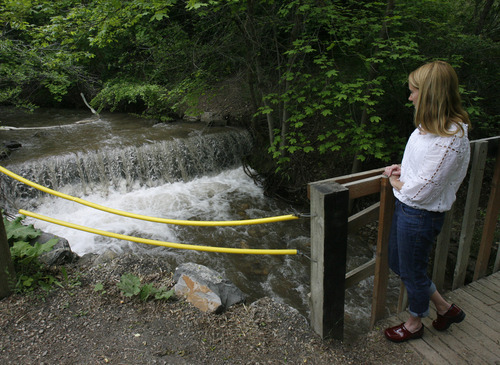This is an archived article that was published on sltrib.com in 2011, and information in the article may be outdated. It is provided only for personal research purposes and may not be reprinted.
On a breezy June day in idyllic Yalecrest, the tarlike stench of oil startles the senses between whiffs of fresh flowers. Along Red Butte Creek, some rocks resemble soccer balls — stained by black patches of crude.
But this is not June 2010. It is June 2011, a year after 33,600 gallons of leaked Chevron oil defiled this urban stream and deprived one of Salt Lake City's showcase neighborhoods of its natural jewel.
Health problems still percolate, at times, along with that unmistakable chemical odor. Homeowners wonder where the workers are — why cleanup crews seemed to skip the winter when the water was low. Nearly 30 residents, miffed at Chevron over filed claims, have turned to a lawsuit.
Neighbors praise the oil giant's cleanup of Liberty Park's polluted pond but question why that same urgency didn't extend to Red Butte. Some are bitter, others cynically detached, but most remain flummoxed by what they consider the lame lip service repeated by the company and City Hall.
As the calendar and the headlines have flipped, this east-bench hamlet feels forsaken.
"How do you put a price on not being able to go into your backyard for a year?" asks Patricia Callahan, whose creekside sandbags — left over from the 1983 floods — still are saturated and discolored with oil. "Obviously they didn't get all the oil out. They did a lot of surface cleaning. And they spent a lot of time telling everyone what a good job they did."
Holding a recently plucked petro-stained rock in a backyard abutting Miller Park, friends Kate Jensen and Annie Payne agree Chevron has done the "bare minimum."
"You don't have to be a chemical scientist to pick up a rock and see oil on it," says Jensen, who notices the crude during her regular runs along the creek. "You can smell it. You can see it. You can touch it."
"Everyone argues, 'How clean is clean?' " Payne adds. "It's not clean enough."
Chevron pledges to perform a "riparian corridor assessment" to examine the creek corridor's health as soon as water levels return to normal. The company notes it placed absorbent booms at five creek locations — monitoring each site twice daily — during this spring's high runoff. They say no oil was "spotted" as of early June. "A few areas" of suspected residual oil, they add, have been difficult to access.
"Chevron has been routinely monitoring the water in the creek, and there have been no results that indicate any harmful levels of product remain," spokesman Mickey Driver writes in an email. "Chevron has agreed to an expanded long-term monitoring plan ... for water and soil sampling."
Some residents say Red Butte has long been fouled by gunk dumped into storm drains. Others insist they cannot smell any oil and that Chevron has taken unwarranted flak as the easy corporate villain.
Tell that to Ed Remund, a retired engineer from California whose 1920s cabin, straddling the creek next to his home, suddenly is in jeopardy. Flushes designed to cleanse the creek have eroded the cabin footings, and Remund's flood insurance claim was denied.
"I have more damage than anybody," he says, alleging he was lowballed by Chevron for damages. "They sent a guy out here and came up with a ridiculous, cutthroat amount. I said, 'Forget it.' "
Remund, now a party to the lawsuit, has pleaded with Chevron for a year to complete the cleanup, fortify the rock walls and rebuild the channels threatening the cabin. "They're hoping I die before they have to do anything," the 78-year-old says. "It's crazy. They're politickers on a big-time basis. They figure they don't have to deal with Salt Lake City."
Mayor Ralph Becker says the city's main goal is to satisfy the neighborhood's concerns. "We'll continue to be vigilant in keeping Chevron's feet to the fire," he says. "The effort is by no means completed. It's a work in progress until we, on behalf of the residents, are satisfied."
The city is negotiating with Chevron about damage payments. And the mayor says the city's partnership with the Utah and Salt Lake Valley health departments to address health problems will continue.
"Our community has never lived through an incident as significant as this," Becker says. "This is going to be an ongoing process for some time. I don't know what some time means."
Jeff Niermeyer, the city's director of public utilities, predicts it will be several years before restoration wraps up. He notes state rules require two years of quarterly monitoring, including water sampling. If any of those tests come back dirty, that two-year clock resets.
Still, Utah Rivers Council Executive Director Zach Frankel wonders where Gov. Gary Herbert has been. "I have to throw the gauntlet at the governor's feet — he's been noticeably absent," Frankel says. "Why does the governor not care about the public? Guys wandering down the creek last June with brooms is not cleanup."
Herbert spokeswoman Ally Isom says the governor is sensitive to the health impact on residents and that their concern about long-term effects is "certainly understandable."
"Consequently," Isom writes by email, "the governor has asked the state's Department of Environmental Quality to fully analyze if it is appropriate and legal to use its authority to assess Chevron additional fines to assist in funding a longitudinal health study."
Biologist Peter Hayes also has a home that straddles the water on stilts. His soil samples, tested by an independent lab, reveal much higher levels of oil than similar tests conducted by Chevron.
Callahan, whose property line is four feet from the creek, is not surprised. In April, when the odor was particularly bad, she called the Fire Department. "They were concerned there had been another spill."
Callahan still suffers from rashes and eye irritation after spending time in her backyard. But she may be the lucky one. Her daughter, who passed out a few weeks after last June's spill during her internship at Primary Children's Medical Center, has suffered more seizure-type bouts since.
"We have no idea if it's correlated," Callahan says. "But we don't know that it's not."
Is Chevron planning to relocate pipeline?
Chatter swirling from the Salt Lake City Mayor's Office to the Utah Rivers Council suggests Chevron may hire a contractor to study the prospect of relocating the company's accident-prone pipeline, which stretches from Colorado to an oil refinery in north Salt Lake City.
Rivers Council Executive Director Zach Frankel has heard those rumors, and Mayor Ralph Becker says, "I was told by the Chevron people that that was one of the options they were looking at."
After Chevron's second oil spill from the same pipeline in December, Becker called for such a study.
"As for the issue of alternative pipeline routes," Chevron spokesman Mickey Driver says, "Chevron is currently evaluating several alternatives. The evaluation is ongoing."
Derek P. Jensen —
About the spills
Two leaks from a Chevron pipeline spilled 54,600 gallons of crude oil near Red Butte Garden in Salt Lake City's eastern foothills last year.
A June 11-12 spill unleashed 33,600 gallons of crude, scarring Red Butte Creek, the Liberty Park pond and parts of the Jordan River. The pipe reopened little more than a week later on June 21. The spill cost Chevron $423,600 in federal fines.
A second, Dec. 1 spill spewed 21,000 gallons near Red Butte Garden's amphitheater. The pipeline reopened, with safety upgrades, two months later on Feb. 1. The Liberty Park pond, however, didn't reopen until May 14 — almost a year after the first spill. —
Then and now — in pictures
O Stroll through a photo gallery off Liberty Park from the past century — along with pictures of how the park looks now compared with right after last year's spill.


